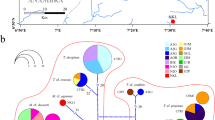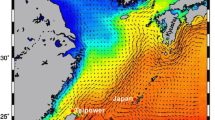Abstract
The diversity, phylogenetic relationships, and demographic history of glacial relict copepod Limnocalanus macrurus from estuaries of large Siberian Arctic rivers (the Ob, Khatanga, Lena, Indigirka, and Kolyma) are studied using mitochondrial cytochrome oxidase subunit I gene (COI mtDNA). It is shown that Siberian populations of Limnocalanus macrurus, together with those from the Canadian Arctic and Baltic Sea, belong to a single Palearctic phylogenetic lineage, which probably survived in one refugium during the Last Glacial Maximum and then rapidly expanded within the Arctic about 21 000–7500 years ago. The presence of common haplotypes in L. macrurus from three Arctic seas and the lack of differences in haplotype frequencies may be associated with recent origin of populations or current gene flow between them.


Similar content being viewed by others
REFERENCES
E. G. Arashkevich, M. V. Flint, A. B. Nikishina, et al., “The role of zooplankton in the transformation of the organic matter in the Ob estuary, on the shelf, and in the deep regions of the Kara Sea,” Oceanology (Engl. Transl.) 50, 780–792 (2010).
E. G. Arashkevich, A. V. Drits, A. F. Pasternak, et al., “Distribution and feeding of herbivorous zooplankton in the Laptev Sea,” Oceanology (Engl. Transl.) 58, 381–395 (2018).
M. E. Vinogradov, E. A. Shushkina, L. P. Lebedeva, et al., “Mesoplankton of the eastern part of the Kara Sea and estuaries of Ob and Yenisei rivers,” Okeanologiya (Moscow) 34, 716–723 (1994).
A. V. Drits, A. B. Nikishina, T. N. Semenova, et al., “Spatial distribution and feeding of dominant zooplankton species in the Ob River estuary,” Oceanology (Engl. Transl.) 56, 382–394 (2016).
M. V. Flint, T. N. Semenova, E. G. Arashkevich, et al., “Structure of the zooplankton communities in the region of the Ob River’s estuarine frontal zone,” Oceanology (Engl. Transl.) 50, 766–779 (2010).
L. L. Chislenko, “Species composition and distribution of ecological complexes of zooplankton in the Yenisei Bay,” Issled. Fauny Morei 12, 228–238 (1972).
S. J. Adamowicz, S. Menu-Marcue, S. A. Halse, et al., “The evolutionary diversification of the Centropagidae (Crustacea, Calanoida): A history of habitat shifts,” Mol. Phylogenet. Evol. 55, 418–430 (2010).
J. April, R. H. Hanner, A.-M. Dion-Coté, and L. Bernatchez, “Glacial cycles as an allopatric speciation pump in north-eastern American freshwater fishes,” Mol. Ecol. 22, 409–422 (2013).
J. C. Avise, D. Walker, and G. C. Johns, “Speciation durations and Pleistocene effects on vertebrate phylogeography,” Proc. R. Soc. London, Ser. B 265, 1707–1712 (1998). https://doi.org/10.1098/rspb.0492
Bernatchez L. and Wilson, C.C. “Comparative phylogeography of Nearctic and Palearctic fishes,” Mol. Ecol. 7, 431–452 (1998).
T. E. Bowman and A. Long, “Relict populations of Drepanopus bungei and Limnocalanus macrurus grimaldii (Copepoda: Calanoida) from Ellesmere Island, N.W.T.,” Arctic 21, 173–180 (1973).
J. E. Buhay, “COI-like” sequences are becoming problematic in molecular systematic and DNA barcoding studies,” J. Crustacean Biol. 29, 96–110 (2009). https://doi.org/10.1651/08-3020.1
E. D. Crandall, E. J. Sbrocco, T. S. DeBoer, et al., “Expansion dating: calibrating molecular clocks in marine species from expansions onto the Sunda shelf following the Last Glacial Maximum,” Mol. Biol. Evol. 29, 707–719 (2012).
C. C. Caudill and A. Bucklin, “Molecular phylogeography and evolutionary history of the estuarine copepod, Acartia tonsa, on the northwest Atlantic coast,” Hydrobiologia 511, 91–102 (2004).
J. Chappell, A. Omura, T. Esat, et al., “Reconciliation of late Quaternary sea levels derived from coral terraces at Huon Peninsula with deep sea oxygen isotope records,” Earth Planet Sci. Lett. 141, 227–236 (1996).
R. T. Dooh, S. J. Adamowicz, and P. D. N. Hebert, “Comparative phylogeography of two North American ‘glacial relict’ crustaceans,” Mol. Ecol. 15, 4459–4475 (2006).
A. V. Drits, A. F. Pasternak, A. B. Nikishina, et al., “The dominant copepods Senecella siberica and Limnocalanus macrurus in the Ob estuary: Ecology in a high-gradient environment,” Polar Biol. 39, 1527–1538 (2016).
L. Excoffier, G. Laval, and S. Schneider, “Arlequin (version 3.0): An integrated software package for population genetics data analysis,” Evol. Bioinf. 1, 47–50 (2005).
O. Folmer, M. Black, W. Hoeh, et al., “DNA primers for amplification of mitochondrial cytochrome c oxidase subunit I from diverse metazoan invertebrates,” Mol. Mar. Biol. Biotechnol. 3, 294–299 (1994).
Y. X. Fu, “Statistical tests of neutrality of mutations against population growth, hitchhiking and background selection,” Genetics 147, 915–925 (1997).
M. W. Gaunt and M. A. Miles, “An insect molecular clock dates the origin of the insects and accords with palaeontological and biogeographic landmarks,” Mol. Biol. Evol. 19, 748–761 (2002).
W. P. Goodall-Copestake, G. A. Tarling, and E. J. Murphy, “On the comparison of population-level estimates of haplotype and nucleotide diversity: A case study using the gene cox1 in animals,” Heredity 109, 50–56 (2012). https://doi.org/10.1038/hdy.2012.12
W. S. Grant, “Problems and cautions with sequence mismatch analysis and bayesian skyline plots to infer historical demography,” J. Hered. 106, 333–346 (2015). https://doi.org/10.1093/jhered/esv020
H. C. Harpending, “Signature of ancient population growth in a low-resolution mitochondrial DNA mismatch distribution,” Hum. Biol. 66, 591–600 (1994).
J. E. Havel and J. B. Shurin, “Mechanisms, effects, and scales of dispersal in freshwater zooplankton,” Limnol. Oceanogr. 49, 1229–1238 (2004).
P. D. N. Hebert and B. J. Hann, “Patterns in the composition of arctic tundra pond microcrustacean communities,” Can. J. Fish. Aquat. Sci. 43, 1416–1425 (1986). https://doi.org/10.1139/f86-175
G. M. Hewitt, “Genetic consequences of climatic oscillations in the Quaternary,” Philos. Trans. R. Soc., B 359, 183–195 (2004).
H.-J. Hirche, I. Fetzer, M. Graeve, and G. Kattner, “Limnocalanus macrurus in the Kara Sea (Arctic Ocean): An opportunistic copepod as evident from distribution and lipid patterns,” Polar Biol. 26, 720–726 (2003). https://doi.org/10.1007/s00300-003-0541-9
C. Holmquist, “The genus Limnocalanus (Crustacea, Copepoda),” Z. Zool. Syst. Evolutionsforsch. 8, 73–296 (1970).
B. G. Holt, J.-P. Lessard, M. K. Borregaard, et al., “An update of Wallace’s zoogeographic regions of the World,” Science 339, 74–78 (2013). https://doi.org/10.1126/science.1228282
M. Kearse, R. Moir, A. Wilson, et al., “Geneious Basic: An integrated and extendable desktop software platform for the organization and analysis of sequence data,” Bioinformatics 28 (12), 1647–1649 (2012).
N. Knowlton and L. A. Weigt, “New dates and new rates for divergence across the Isthmus of Panama,” Proc. R. Soc. London, Ser. B 265, 2257–2263 (1998).
K. Lambeck, T. M. Esat, and E. K. Potter, “Links between climate and sea levels for the past three million years,” Nature 419, 199–206 (2002).
P. Librado and J. Rozas, “DnaSP v5: A software for comprehensive analysis of DNA polymorphism data,” Bioinformatics 25, 1451–1452 (2009).
M. P. Miller, TFPGA Version 1.3: A Windows Program for the Analysis of Allozyme and Molecular Population Genetic Data (Northern Arizona University, Flagstaff, AZ, 1997), p. 30. http://www.marksgeneticsoftware.net/.
K. G. Miller, M. A. Kominz, J. V. Browning, et al., “The Phanerozoic record of global sea-level change,” Science 310, 1293–1298 (2005).
K. L. Millette, S. Xu, J. D. S. Witt, and M. E. Cristescu, “Pleistocene-driven diversification in freshwater zooplankton: Genetic patterns of refugial isolation and postglacial recolonization in Leptodora kindtii (Crustacea, Cladocera),” Limnol. Oceanogr. 56, 1725–1736 (2011). https://doi.org/10.4319/lo.2011.56.5.1725
P. J. Milligan, E. A. Stahl, N. V. Schizas, and J. T. Turner, “Phylogeography of the copepod Acartia hudsonica in estuaries of the northeastern United States,” Hydrobiologia 666, 155–165 (2011). https://doi.org/10.1007/s10750-010-0097-y
B. J. Peterson, R. M. Holmes, J. W. McClelland, et al., “Increasing river discharge to the Arctic Ocean,” Science 298, 2171–2173 (2002).
S. E. Ramos-Onsins and J. Rozas, “Statistical properties of new neutrality tests against population growth,” Mol. Biol Evol. 19, 2092–2100 (2002).
N. Ray, M. Currat, and L. Excoffier, “Intra-deme molecular diversity in spatially expanding populations,” Mol. Biol. Evol. 20, 76–86 (2003).
M. L. Raymond and F. Rousset, “An exact test for population differentiation,” Evolution 49, 1280–1283 (1995).
K. E. Ricker, “The origin of two glacial relict crustaceans in North America, as related to Pleistocene glaciations,” Can. J. Zool. 37, 871–893 (1959).
A. R. Rogers and H. Harpending, “Population growth makes waves in the distribution of pairwise genetic differences,” Mol. Biol. Evol. 9, 552–569 (1992).
J. C. Roff, “Aspects of the reproductive biology of the planktonic copepod Limnocalanus macrurus Sars,” Crustaceana (Leiden) 22, 155–160 (1972).
J. C. Rolf and J. H. C. Carter, “Life cycle and seasonal abundance of the copepod Limnocalanus macrurus Sars in a high arctic lake,” Limnol. Oceanogr. 17, 363–370 (1972).
L. Samchyshyna, L. A. Hansson, and K. S. Christoffersen, “Patterns in the distribution of Arctic freshwater zooplankton related to glaciation history,” Polar Biol. 31, 1427–1435 (2008). https://doi.org/10.1007/s00300-008-0482-4
C. D. Schubart, R. Diesel, and S. B. Hedges, “Rapid evolution to terrestrial life in Jamaican crabs,” Nature 393, 363–365 (1998). https://doi.org/10.1038/30724
I. Spikkeland, B. Kinsten, G. Kjellberg, et al., “The aquatic-glacial relict fauna of Norway—an update of distribution and conservation status,” Fauna Norv. 36, 51 (2016). https://doi.org/10.5324/fn.v36i0.1994
P. Taberlet, L. Fumagalli, A. G. Wust-Saucy, and J.‑F. Cossons, “Comparative phylogeography and postglacial colonization routes in Europe,” Mol. Ecol. 7, 453–464 (1998).
F. Tajima, “Statistical methods to test for nucleotide mutation hypothesis by DNA polymorphism,” Genetics 123, 585–595 (1989).
P. van Hove, K. M. Swadling, J. A. E. Gibson, et al., “Farthest north lake and fjord populations of calanoid copepods Limnocalanus macrurus and Drepanopus bungei in the Canadian high Arctic,” Polar Biol. 24, 303–307 (2001).
Funding
Expeditionary work and primary processing of material was supported by the Russian Foundation for Basic Research, project no. 18-05-60 069, and state task no. 0149-2019-0008; laboratory analysis was performed within the framework of state assignment no. 0112-2019-0001.
Author information
Authors and Affiliations
Corresponding author
Additional information
Translated by A. Lisenkova
Rights and permissions
About this article
Cite this article
Gordeeva, N.V., Drits, A.V. & Flint, M.V. Genetic Diversity of Copepod Limnocalanus macrurus from Russian Arctic Seas. Oceanology 59, 903–911 (2019). https://doi.org/10.1134/S0001437019060067
Received:
Revised:
Accepted:
Published:
Issue Date:
DOI: https://doi.org/10.1134/S0001437019060067




